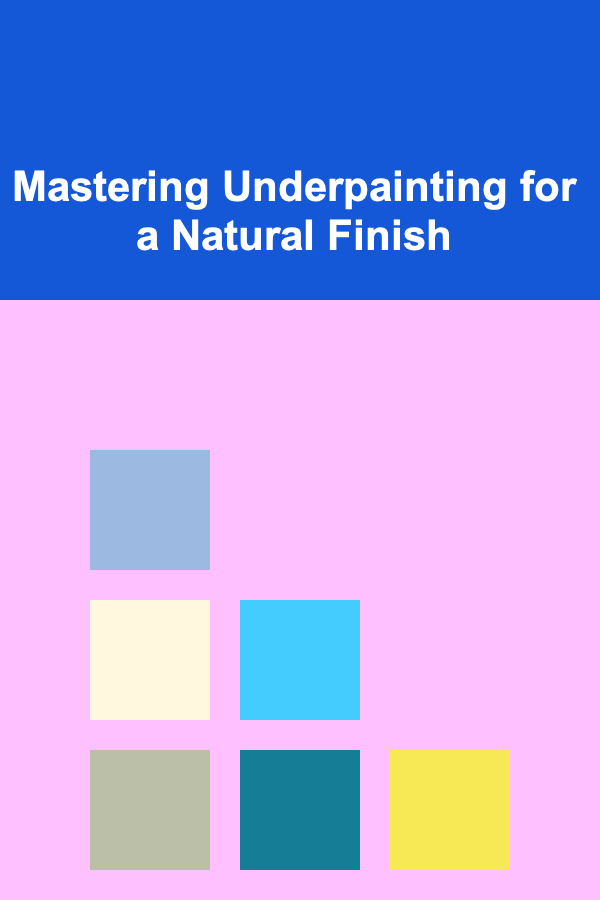
Mastering Underpainting for a Natural Finish
ebook include PDF & Audio bundle (Micro Guide)
$12.99$10.99
Limited Time Offer! Order within the next:

Underpainting, an age-old technique used by master painters, is a crucial step in achieving depth, realism, and a natural finish in your artwork. Often overlooked by beginners, it provides a foundational layer that sets the stage for subsequent layers of color and detail. This comprehensive guide will delve into the intricacies of underpainting, exploring its benefits, various techniques, color choices, and best practices, ultimately empowering you to elevate your painting skills and create stunning, lifelike artwork.
What is Underpainting?
At its core, underpainting is the process of applying a preliminary layer of paint to a canvas or other painting surface before adding the final layers of color. This initial layer serves as a roadmap for the painting, establishing values, composition, and overall tone. Think of it as the skeletal structure of a building; it provides the necessary support and framework for everything that follows.
Historically, underpainting was commonly executed in monochrome or a limited palette of neutral colors, often using earth tones like burnt umber, raw sienna, or grays. This allowed artists to focus on accurately capturing the form and lighting of their subject without the distraction of vibrant colors. Modern artists continue to use these traditional methods, but also explore a wider range of color options to achieve specific effects and enhance the final outcome.
The Benefits of Underpainting
Underpainting offers a multitude of advantages that contribute to a more successful and refined painting. Here are some key benefits:
- Value Structure: Underpainting is invaluable for establishing a strong value structure, which is the foundation of realism. By accurately representing the light and shadow patterns in your subject, you create a sense of depth and form. The subsequent layers of color will then build upon this foundation, enhancing the illusion of three-dimensionality.
- Color Harmony: A well-executed underpainting can help to unify the color palette of your painting. By subtly influencing the overlying layers, the underpainting can create a sense of harmony and coherence. This is particularly useful when working with a complex subject matter or a wide range of colors.
- Correction and Adjustment: It provides an opportunity to identify and correct any compositional errors or inaccuracies in your initial sketch before committing to the final colors. Adjustments are much easier to make at this stage, saving you time and frustration later on.
- Increased Depth and Luminosity: Underpainting can create a sense of depth and luminosity by allowing the underlying layers to subtly peek through the final colors. This effect is particularly noticeable in areas of shadow and highlights, adding complexity and visual interest to the painting.
- Improved Color Accuracy: By establishing a base tone, the underpainting makes it easier to judge the accuracy of the final colors. It provides a reference point for comparing and contrasting the various hues, leading to more realistic and nuanced color mixing.
- Enhanced Texture: The texture of the underpainting can subtly influence the final texture of the painting. Applying the underpainting with different brushes or techniques can create interesting effects that add depth and visual appeal.
- Faster Completion Time: While it seems counterintuitive, underpainting can often speed up the overall painting process. By resolving issues of value and composition early on, you can focus on the details and nuances of color in the final layers, leading to a more efficient and enjoyable painting experience.
Underpainting Techniques: A Comprehensive Overview
Several different underpainting techniques can be employed, each offering its own unique advantages and characteristics. The choice of technique will depend on your personal style, the subject matter, and the desired outcome.
1. Grisaille
Grisaille is a monochromatic underpainting technique that utilizes shades of gray to establish the value structure of the painting. It is a classic and versatile method that has been used by artists for centuries. Grisaille is particularly well-suited for creating realistic and detailed paintings.
How to execute a Grisaille underpainting:
- Prepare your canvas: Ensure your canvas is properly primed and ready to accept paint.
- Sketch your subject: Lightly sketch your subject onto the canvas, paying attention to proportion and composition.
- Mix your grays: Create a range of gray tones by mixing black and white paint. You can also add small amounts of other colors, such as burnt umber or blue, to create warmer or cooler grays.
- Apply the grays: Begin by applying the darkest grays to the shadow areas and the lightest grays to the highlight areas. Gradually build up the values, blending the transitions between the different tones.
- Refine the details: Pay attention to the subtle nuances of light and shadow, and refine the details of the underpainting as needed.
- Let it dry: Allow the underpainting to dry completely before proceeding to the next layer.
Example: Imagine painting a portrait using the Grisaille technique. You would first sketch the portrait's features. Then, you'd use shades of gray to define the light and shadows on the face, creating the form and structure. This gray underpainting would then serve as the foundation for adding skin tones and other colors in subsequent layers.
2. Verdaccio
Verdaccio is another traditional underpainting technique that employs a range of greenish-gray tones. This technique is particularly effective for portrait painting, as the greenish undertones can help to neutralize the red tones in the skin, resulting in a more natural and lifelike appearance.
How to execute a Verdaccio underpainting:
- Prepare your canvas: Prime your canvas.
- Sketch your subject: Lightly sketch.
- Mix your Verdaccio tones: Mix your paints to achieve different values of greenish-gray. A typical mixture includes white, black, and a green pigment like Terre Verte or Green Earth. You can adjust the proportions to create warmer or cooler variations.
- Apply the Verdaccio tones: Apply the tones just like you would in Grisaille, focusing on the light and shadow areas.
- Refine and dry: Refine details and allow to dry.
Example: When painting a portrait using Verdaccio, the subtle green undertones in the underpainting will help to counteract the redness of the skin, creating a more balanced and natural skin tone in the final painting. This is especially useful for subjects with rosy complexions.
3. Imprimatura
Imprimatura is a technique that involves applying a thin, transparent wash of color to the entire canvas. This wash serves as a unifying layer that helps to harmonize the colors in the painting. It also provides a slightly toned background, making it easier to judge the values and colors in the subsequent layers.
How to execute an Imprimatura underpainting:
- Prepare your canvas: Ensure your canvas is properly primed.
- Choose your color: Select a color for your imprimatura. Earth tones like raw sienna, burnt umber, or yellow ochre are commonly used, but you can also experiment with other colors.
- Thin the paint: Thin the paint with a solvent, such as turpentine or mineral spirits, to create a thin, transparent wash.
- Apply the wash: Apply the wash evenly over the entire canvas, using a large brush.
- Wipe off (optional): You can wipe off some of the paint with a clean cloth to create variations in tone and texture.
- Let it dry: Allow the imprimatura to dry completely before proceeding to the next layer.
Example: Imagine painting a landscape with a vibrant sunset. An Imprimatura of yellow ochre can create a warm, glowing base that enhances the sunset colors in the final painting. This thin wash will subtly influence all subsequent layers, creating a sense of overall warmth and luminosity.
4. Color Blocking
Color blocking involves applying distinct areas of color to the canvas to represent the local colors of the subject. This technique is particularly useful for creating bold and expressive paintings. It focuses on establishing the general color relationships before adding details.
How to execute a Color Blocking underpainting:
- Prepare your canvas: Prime your canvas.
- Sketch your subject: Sketch lightly.
- Identify local colors: Observe your subject carefully and identify the dominant colors in different areas.
- Mix your colors: Mix your paints to match the local colors you identified.
- Apply the colors: Apply the colors to the corresponding areas of the canvas, using bold, simplified shapes. Don't worry about details at this stage.
- Blend (optional): You can blend the edges of the color blocks to create smoother transitions, or leave them sharp for a more graphic effect.
- Let it dry: Allow the underpainting to dry before the next layer.
Example: When painting a still life with a red apple, a yellow banana, and a blue vase, you would block in these areas with their respective colors in the underpainting. This sets the stage for building up the details and nuances of color in later layers. The color blocking provides a quick and effective way to establish the overall color scheme of the painting.
5. Tonal Underpainting (Value Painting)
Similar to Grisaille, a tonal underpainting focuses on establishing the values (light to dark) using a limited palette, but it can incorporate slight color variations. This technique is ideal for creating a strong sense of form and depth. It emphasizes the accurate rendering of light and shadow.
How to execute a Tonal Underpainting:
- Prepare your canvas: Prime the canvas.
- Sketch the subject: Create a light sketch.
- Mix tonal values: Create a range of values using a limited palette. Earth tones or a mixture of black, white, and a touch of color (like blue or red) works well.
- Apply values strategically: Apply the darkest values in shadow areas and the lightest values in highlight areas. Blend transitions smoothly to create a sense of form.
- Refine details: Focus on accurately representing the light and shadow patterns.
- Dry thoroughly: Let the underpainting dry completely.
Example: For a dramatic landscape painting, a tonal underpainting could depict the stark contrast between a sunlit mountain range and a deep, shadowed valley. This strong value structure will create a powerful sense of depth and atmosphere in the final painting.
Choosing the Right Colors for Your Underpainting
The color of your underpainting can significantly impact the final appearance of your painting. While traditional underpainting often utilizes monochrome or neutral colors, there are many other options to consider, depending on the desired effect.
Neutral Colors (Gray, Brown, Umber)
Neutral colors are a safe and versatile choice for underpainting. They provide a solid foundation for building up the values and colors in the subsequent layers without interfering with the final palette. Grays are excellent for achieving a realistic and balanced look, while browns and umbers can add warmth and richness to the painting. These are particularly useful when aiming for photorealism or a classic, traditional style.
Earth Tones (Raw Sienna, Yellow Ochre, Burnt Sienna)
Earth tones are warm and natural colors that can create a sense of harmony and unity in the painting. They are particularly well-suited for landscape painting and portrait painting. Raw sienna provides a subtle warmth, while yellow ochre adds a golden glow. Burnt sienna can be used to create rich, reddish-brown tones. Earth tones can create a vintage or aged look to the final artwork.
Complementary Colors
Using complementary colors in your underpainting can create a sense of vibrancy and visual interest in the final painting. For example, using a red underpainting beneath a green object can enhance the intensity of the green and create a more dynamic composition. This technique requires careful consideration and experimentation, but the results can be stunning. This is often employed in more contemporary and expressive styles.
Limited Palette
Using a limited palette of colors in your underpainting can help to simplify the painting process and create a sense of color harmony. By restricting yourself to a few key colors, you can focus on the essential aspects of the painting, such as value and composition. This also forces you to mix colors effectively and learn how different pigments interact. A limited palette can lead to a cohesive and well-balanced final piece.
Best Practices for Underpainting
To ensure that your underpainting is successful, it is important to follow some best practices. These guidelines will help you avoid common pitfalls and maximize the benefits of this valuable technique.
- Thin your paint: Always thin your paint with a suitable medium, such as turpentine or mineral spirits, to create a smooth, even layer. Thick paint can obscure the details of the underpainting and make it difficult to apply subsequent layers.
- Work in thin layers: Apply the underpainting in thin, translucent layers, allowing each layer to dry completely before proceeding to the next. This will prevent the colors from becoming muddy and allow the light to penetrate through the layers, creating a sense of depth.
- Use the right brushes: Use brushes that are appropriate for the size and detail of your painting. Small, fine brushes are ideal for refining details, while larger brushes are better for covering large areas.
- Consider the drying time: Be aware of the drying time of your paints and mediums. Oil paints, for example, can take several days to dry completely, while acrylic paints dry much faster. Adjust your painting schedule accordingly.
- Don't overwork the underpainting: The underpainting is meant to be a foundation, not a finished painting. Avoid overworking the details and focus on establishing the overall values and composition.
- Experiment and practice: The best way to master underpainting is to experiment with different techniques and colors. Practice on scrap canvases or panels to develop your skills and find what works best for you.
- Allow for adjustments: Be prepared to make adjustments to your underpainting as you proceed with the painting. The underpainting is a guide, but it is not set in stone. You may need to make changes to the values, colors, or composition as the painting evolves.
- Protect your underpainting: Once your underpainting is dry, you can apply a thin layer of varnish to protect it from dust and dirt. This will also help to create a smoother surface for the subsequent layers of paint.
Materials for Underpainting
Having the right materials is essential for achieving successful underpainting results. Here's a list of key materials to consider:
- Canvas or Painting Surface: Choose a high-quality canvas or panel that is properly primed. The surface should be smooth and absorbent, allowing the paint to adhere properly.
- Paints: Select your paints based on the technique you're using. Oil paints, acrylics, and even watercolors can be used for underpainting. Consider the opacity and transparency of the paints, as this will affect the final result. Earth tones, grays, and complementary colors are all good options.
- Brushes: Invest in a variety of brushes in different sizes and shapes. Round brushes are ideal for details, while flat brushes are better for covering larger areas. Consider using synthetic or natural bristle brushes, depending on your preference and the type of paint you're using.
- Mediums: Use mediums to thin your paints and adjust their consistency. Linseed oil, turpentine, mineral spirits, and acrylic mediums are all common options. Choose a medium that is compatible with your paints and that will help you achieve the desired effect.
- Palette: Use a palette to mix your paints. A glass palette is easy to clean, while a disposable palette is convenient for quick projects.
- Palette Knife: A palette knife is useful for mixing paints and for applying thick layers of paint.
- Rags or Paper Towels: Keep rags or paper towels on hand for cleaning your brushes and wiping away excess paint.
- Solvents: Use solvents like turpentine or mineral spirits to clean your brushes and thin your paints.
- Varnish (Optional): Apply a thin layer of varnish to protect your underpainting from dust and dirt.
Conclusion
Mastering underpainting is a rewarding journey that will undoubtedly enhance your artistic skills and enable you to create more compelling and realistic artwork. By understanding the benefits, exploring different techniques, choosing the right colors, and following best practices, you can unlock the full potential of this powerful tool. Remember that practice and experimentation are key to mastering any artistic technique. Embrace the process, be patient with yourself, and enjoy the creative exploration. With dedication and perseverance, you will be well on your way to creating stunning, lifelike paintings that capture the beauty and complexity of the world around you.

How to Clean and Care for Hardwood Floors
Read More
How to Clean Your Oven and Keep It Looking Like New
Read More
How to Keep Your Home's Fireplace in Working Order
Read More
How to Make Your Rental Property Stand Out in a Crowded Market
Read More
How To Pack Food for a Long Backpacking Trip
Read More
Understanding Quantum Machine Learning
Read MoreOther Products

How to Clean and Care for Hardwood Floors
Read More
How to Clean Your Oven and Keep It Looking Like New
Read More
How to Keep Your Home's Fireplace in Working Order
Read More
How to Make Your Rental Property Stand Out in a Crowded Market
Read More
How To Pack Food for a Long Backpacking Trip
Read More